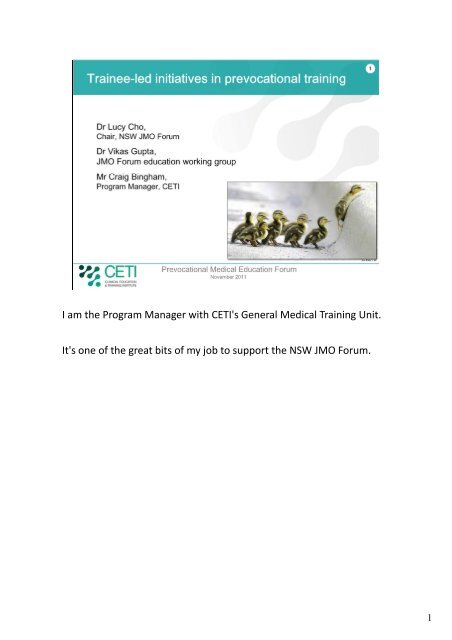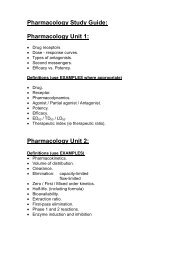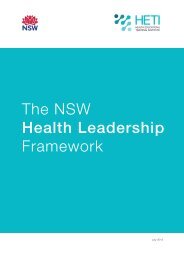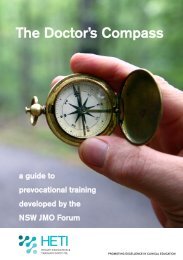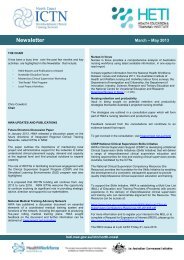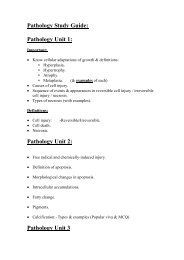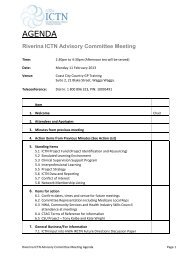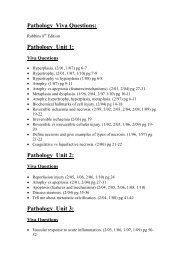Trainee-led initiatives in prevocational training - HETI
Trainee-led initiatives in prevocational training - HETI
Trainee-led initiatives in prevocational training - HETI
You also want an ePaper? Increase the reach of your titles
YUMPU automatically turns print PDFs into web optimized ePapers that Google loves.
I am the Program Manager with CETI's General Medical Tra<strong>in</strong><strong>in</strong>g Unit.It's one of the great bits of my job to support the NSW JMO Forum.1
The Forum is a tra<strong>in</strong>ee‐representative advisory subcommittee of theNSW Prevocational Tra<strong>in</strong><strong>in</strong>g Council. It is composed of elected tra<strong>in</strong>eerepresentatives from the 15 tra<strong>in</strong><strong>in</strong>g networks that make up the<strong>prevocational</strong> tra<strong>in</strong><strong>in</strong>g program <strong>in</strong> NSW and the ACT.Each year each network elects a new PGY1 representative, who willserve on the Forum for two years. We also elect rural reps from themajor rural tra<strong>in</strong><strong>in</strong>g sites <strong>in</strong> NSW, mak<strong>in</strong>g about 34 or 35 reps. Abouthalf of the Forum is new each year, and half are carry<strong>in</strong>g on from theprevious year, and this system provides both a regular flow of newideas and a degree of cont<strong>in</strong>uity.2
The basic message of our presentation today is simple: JMOs are adultlearners and enthusiastic employees who have the <strong>in</strong>terest,<strong>in</strong>volvement, ideas and <strong>in</strong>nocence required to attempt <strong>in</strong>novations <strong>in</strong>medical education and tra<strong>in</strong><strong>in</strong>g. It makes good sense pedagogically andadm<strong>in</strong>istratively to give them a lead<strong>in</strong>g role <strong>in</strong> shap<strong>in</strong>g the system <strong>in</strong>which they will learn and work.I am sure that most of you are already act<strong>in</strong>g on this know<strong>led</strong>ge <strong>in</strong>some ways, but there are also plenty of forces <strong>in</strong> the system thatoperate aga<strong>in</strong>st tra<strong>in</strong>ee‐<strong>led</strong> <strong><strong>in</strong>itiatives</strong>. Two JMO Forum representativesare go<strong>in</strong>g to give you brief examples of ways <strong>in</strong> which tra<strong>in</strong>ee‐<strong>led</strong>projects can offer the system new and better ways of do<strong>in</strong>g th<strong>in</strong>gs,achiev<strong>in</strong>g results that would be difficult to reach by other means.3
The JMO forum as a whole identified the lack of a consistent statewide educationprocess. As seen by the graphic formal teach<strong>in</strong>g varied widely not only acroos the 15<strong>prevocational</strong> networks <strong>in</strong> NSW but from hospital to hospital. and over the last two yearsthere has been a susta<strong>in</strong>ed and concerted effort by the tra<strong>in</strong>ees to address a few keyareas. this from a ground up driven process which thanks to the wholehearted and <strong>in</strong>many cases overwhelm<strong>in</strong>g support from DPETs and JMO managersAddit:Of the 27 hospitals represented here•Average teach<strong>in</strong>g hours per week = 1.5–24 hospitals have 1 hour per week–17 hospitals have >1 hour per week• 49% (22/45) are pager protected5
Rather than refer to an expert panel with a multitude of committees which is probablythe more politically correct and academically rigorous way of do<strong>in</strong>g it … the JMOs <strong>in</strong> theEducation work<strong>in</strong>g group went away and came up with what we as Junior Doctors feltwas of most value <strong>in</strong> each topic6
In some ways we were like charg<strong>in</strong>g horses with bl<strong>in</strong>kers – quite oblivious to the ruff<strong>led</strong>feathers or the potential fallout8
11 out of 15 had implementedAccord<strong>in</strong>g to the JMO respondents, of the 11 hospitals <strong>in</strong> this poll that had implementedthe series 10 had done so effectively and was well received. Obviously this is a smallsample and its early days given the proposal was sent out at the end of last year.We are hop<strong>in</strong>g to repeat the 2010 survey with a much larger number of hospitalssurveyed later next year.This is not to say this is a perfect system –one of the common criticisms is that there istoo much expected from each teach<strong>in</strong>g session than can be adequately deliveredWhat it is, is a prime example9
In 2011 our focus changed to address the oft neglected part of the ACFJD10
So why bother with tra<strong>in</strong>ee <strong>led</strong> <strong>in</strong>itiavesWell theres the chance to play god –create tomorrows achievers <strong>in</strong> your own image13
Thanks Vikas. I’d like to tell you about two more projects that the members of the JMOForum has been <strong>in</strong>volved with. The first occurred at a local health network level wherethe JMO Forum was asked to get <strong>in</strong>volved with the NSW Health Services ImprovementBranch Acute Care Taskforce who were particularly look<strong>in</strong>g at JMO Handover. Dr HamishDunn has already discussed the content of the f<strong>in</strong>d<strong>in</strong>gs <strong>in</strong> another presentation at thisevent.16
In the follow<strong>in</strong>g year the JMO Forum undertook a statewide audit of handover, thedetails of which you can see on the slide and the results of which have been used byNSW Health to focus handover improvement across the state. The po<strong>in</strong>t be<strong>in</strong>g that therewas no possible way this audit could have been conducted without JMO buy‐<strong>in</strong> andownership. This was acknow<strong>led</strong>ged by NSW Health.17
The second project was devised and executed by the Careers work<strong>in</strong>g party of the JMOForum who have compi<strong>led</strong> a Doctors GPS guidebook to navigat<strong>in</strong>g specialty tra<strong>in</strong><strong>in</strong>g. Intheir own time the work<strong>in</strong>g party members contacted all relevant specialty colleges andhave put together a one stop shop <strong>in</strong>formation resource for <strong>in</strong>terns and residents for allmajor specialty pathways. This publication is <strong>in</strong> f<strong>in</strong>al draft and will be published andreviewed biannually as an official NSW Health CETI publication.18
There are numerous other JMO <strong>led</strong> projects out there which I don’t have time to tell youabout and which I’m sure many of you are <strong>in</strong>volved <strong>in</strong>. The key po<strong>in</strong>t I would like toreiterate is that these projects are the result of volunteer time and energy and peoplewho believe <strong>in</strong> what they are try<strong>in</strong>g to do. They only earn a budget as a result of theirquality and utility. They are owned by the JMOs who seek <strong>in</strong>put, feedback and supportas needed from people who believe that they have someth<strong>in</strong>g valuable to offer.20
Colloboration, mentor<strong>in</strong>g and empower<strong>in</strong>g JMOs can only result <strong>in</strong> good. Even projectswhich fail will ensure some k<strong>in</strong>d of learn<strong>in</strong>g outcome for those <strong>in</strong>volved. It is imperativethat the idea of <strong>in</strong>itiative, ownership and leadership is not lost <strong>in</strong> the JMO experience.JMOs have spent years be<strong>in</strong>g tra<strong>in</strong>ed to identify problems and work towards solutions.Its their day to day job. And they should be do<strong>in</strong>g it outside of the cl<strong>in</strong>ical arena <strong>in</strong> orderto become competent professionals.21
Too often we see the expectation of sudden gravitas and know<strong>led</strong>ge from a cl<strong>in</strong>icalperspective <strong>in</strong> the transition from ‘subservient’ resident to ‘<strong>in</strong> charge’ registrar. Thesame applies to education and tra<strong>in</strong><strong>in</strong>g. Unless junior doctors are encouraged to<strong>in</strong>novate, to question, to look for better ways of do<strong>in</strong>g th<strong>in</strong>gs at local and system levelsthe future looks bleak. We need to create leaders and change drivers for the future now–otherwise there will be no one to sit <strong>in</strong> the seats you now occupy 20 or 30 years fromnow. Sometimes ‘consultation’ is a dirty word. It just means there was a JMO <strong>in</strong> theroom. If you have access to them, f<strong>in</strong>d out what they actually are th<strong>in</strong>k<strong>in</strong>g and <strong>in</strong>volvethem. They may surprise you. If they compla<strong>in</strong> or raise issues –make them part of theteam to fix it, even better make them lead the team with your back<strong>in</strong>g. Eg Roster<strong>in</strong>gwork<strong>in</strong>g groups22
JMOs are a widely untapped resource for quality change and <strong>in</strong>novation. We areconstantly be<strong>in</strong>g chided for our lack of <strong>in</strong>terprofessionalism and encouraged to workbetter and more closely with other staff. Shouldn’t the same hold true at a healthsystem level? JMOs work<strong>in</strong>g with Unit Managers and Directors of Education, collegerepresentatives, medical education officers, medical super<strong>in</strong>tendents. The goals arecommon, so the tracks should stop runn<strong>in</strong>g <strong>in</strong> parallel and start to converge.23
Thanks Lucy. In pursu<strong>in</strong>g their projects, the JMO Forum members are learn<strong>in</strong>g leadershipskills, communication skills, professional practice skills. NSW Health runs a number ofleadership programs for cl<strong>in</strong>icians, but I th<strong>in</strong>k the JMO Forum is one of the bestleadership programs yet devised. They are learn<strong>in</strong>g how the health system works andhow it can be to positively <strong>in</strong>fluenced. As they learn, they are help<strong>in</strong>g to build the futurestrength of education and tra<strong>in</strong><strong>in</strong>g <strong>in</strong> health. This works because the system has25
1 Made space for tra<strong>in</strong>ees to talk2 Given permission for tra<strong>in</strong>ees to act3 Adopted an expectation that tra<strong>in</strong>ee representatives will be tra<strong>in</strong>ee activists.Are there risks associated with this process?26
‐ Risk of revolution? Will tra<strong>in</strong>ees forget who is <strong>in</strong> charge? Not likely.Endorsement and support by senior cl<strong>in</strong>icians tends to be one of the first th<strong>in</strong>gs tra<strong>in</strong>eesseek for their projects, as it is essential if they are go<strong>in</strong>g to get past square one.Rather than revolution, I wonder about the opposite risk ‐‐ that if we don't encouragetra<strong>in</strong>ees to <strong>in</strong>novate, <strong>in</strong>itiate and lead, we may develop a medical workforce that is toopassive <strong>in</strong> the face of accelerat<strong>in</strong>g change, and not sufficiently adapted to the idea thatthey have to make th<strong>in</strong>gs better for themselves and their patients through their own<strong><strong>in</strong>itiatives</strong>.27
‐ Risk of patient harm? We haven't seen this ‐ most education and tra<strong>in</strong><strong>in</strong>g projects areone or two steps removed from patient care, leav<strong>in</strong>g plenty of room for review by seniorcl<strong>in</strong>icians before there could be any un<strong>in</strong>tended negative consequences.28
‐ The biggest risk that I have seen with tra<strong>in</strong>ee‐<strong>led</strong> <strong><strong>in</strong>itiatives</strong> is that there will be<strong>in</strong>advertent miscommunication, because tra<strong>in</strong>ees are not fully aware of thelabyr<strong>in</strong>th<strong>in</strong>e depths of the system <strong>in</strong> which they work, and they are not practiseddiplomats. Word<strong>in</strong>g, tim<strong>in</strong>g, tone and address all matter.‐ There is a risk that JMOs will put people offside because they have not used the rightchannel or the right language, or kissed the right hand. There is sometimes a role forpeople (like me, and the Chair of the Prevocational Tra<strong>in</strong><strong>in</strong>g Council, and directors oftra<strong>in</strong><strong>in</strong>g) <strong>in</strong> provid<strong>in</strong>g an <strong>in</strong>terpreter service that helps translate between the systemand the JMOs, so that their big ideas are not misconstrued or lost.29
So, if there is time, here are my three f<strong>in</strong>al tips:Subtle differences <strong>in</strong> organisation and expectations can lead toprofoundly different outcomes. For example, two years ago the thenchair of the JMO Forum reorganised the forum <strong>in</strong>to work<strong>in</strong>g groups,each one with a specific focus and a project to complete with<strong>in</strong> theyear. This created an expectation on every forum member that theywould get someth<strong>in</strong>g done at the meet<strong>in</strong>gs, not just meet and talk.What has resulted has been a flower<strong>in</strong>g of tra<strong>in</strong>ee creativity.Committees with tra<strong>in</strong>ee representation need to expect tra<strong>in</strong>eeactivism: don’t just ‘tick the box’ by hav<strong>in</strong>g some tra<strong>in</strong>ees show up tothe committee; raise the expectation that tra<strong>in</strong>ees will be activemembers. Give them jobs to do, don’t just ask them to be there. Thismakes be<strong>in</strong>g on the committee so much more worthwhile that itmakes it much easier to get tra<strong>in</strong>ee <strong>in</strong>volvement.Build l<strong>in</strong>ks between tra<strong>in</strong>ees and higher levels of the system: In NSW,CETI advertises the existence of the JMO Forum to other NSW Healthorganisations as a resource that can help solve problems they arework<strong>in</strong>g on. It can really work well to l<strong>in</strong>k the tra<strong>in</strong>ee representatives30
to the higher‐level change agencies <strong>in</strong> the system. This union of shopfloor and boardroom can make proposed changes more realistic and<strong>in</strong>crease stakeholder engagement.30


